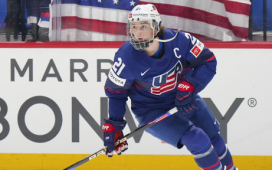We probably should have seen Andrew Copp’s contract coming the moment he and the Winnipeg Jets headed to arbitration.
In recent years, calculating the eventual decision in cases that have made it in front of an arbitrator has been about simple math. How simple? Well, take the team ask, add it to the player ask, divide it by two to split down the middle and – voila! – you’ve got yourself a fairly good idea where the deal is going to land. True to form, too, Copp’s new contract is no different. Asking for $2.9 million with Winnipeg seeking a two-year pact at $1.5 million, pen was put to paper on a two-year, $2.28-million contract once the decision came down. Put another way, Copp received $80,000 more than an exact split of the two proposed contracts. The equation works.
But what we also probably should have seen coming the moment Copp and Winnipeg headed to arbitration is that his making it to a hearing means the already-in-a-bind Jets are going to have to do some clever salary cap maneuvering before the campaign begins.
With Copp now signed, and his arbitrator-decided deal coming mere days after Winnipeg locked Jacob-Trouba-trade-return Neal Pionk in on a two-year, $6-million contract, the Jets now find themselves about to enter the second month of the off-season with a hair less than $17.6-million with which to operate and Patrik Laine and Kyle Connor, their two most important restricted free agents, still unsigned. And now we have to start to wonder if there’s a corresponding move in the offing.
Consider what Laine alone is going to cost on his next deal. Despite a hot-and-cold campaign to close out his entry-level contract, Laine put up 30 goals in what some considered a down year for the sniper, his total buoyed by an 18-goal November but dragged down by a pair of dozen-game scoring droughts. Regardless, his three-year NHL career speaks for itself and for Laine, who is one of the game’s elite sharpshooters. Since his arrival in 2016-17, his 110 goals are more than all but five players and his 184 points make him a top-50 scorer. Put that into context against some notable RFAs and Laine is looking at an easy $8.5-million or more per season, even if that’s on a bridge deal. That was the case even before the Carolina Hurricanes’ Sebastian Aho landed a five-year pact with an $8.454-million cap hit as a result of the Montreal Canadiens’ offer sheet, though it’s truer now.
For the sake of this exercise, though, let’s get even more conservative and estimate that the $8-million range is where Laine lands on a bridge deal. What would that mean for Connor? While he hasn’t showcased the same top-end scoring as Laine, Connor has consecutive 30-goal campaigns and 123 points in 158 games over the past two seasons. Measured against all NHLers over that span, he ranks 20th in goals and 62nd in points. In fact, he’s in much the same company as Matthew Tkachuk, who some have assumed is going to flirt with an $8-million cap hit on a long-term pact. Let’s again get more conservative and suggest a $7-million cap hit for Connor over a six- or seven-year term.
Once more, with feeling, these are conservative – and incredibly team-friendly – estimates. Even still, they combine for a $15-million cap hit, which means the Jets would then have $2.6-million with which to work. And they’re going to need it. You see, with Laine and Connor inked, Winnipeg has only 10 clear-cut NHL forwards on the roster and an overall roster size of 19. At minimum, the Jets need to add at least one more player to the opening-day roster. Realistically, however, Winnipeg will require another pair of forwards, unless they intend to run 11 attackers and seven blueliners for the duration of the season. This is where things get particularly tricky.
Ideally, the Jets would fill those spots with a pair of players with league-minimum salaries, which would combine to count for $1.4-million against the cap. The more likely scenario, however, will see Winnipeg insert Kristian Vesalainen and Mason Appleton into the lineup. Their combined cap hit, however, is $1.64 million, which then leaves the Jets with less than $1-million in cap flexibility, which is a less-than-ideal situation.
The easy answer, of course, would be to then flip someone to the minors. Ah, but there’s a snag there, too. The only players on the Jets’ projected roster who are waiver exempt are Jack Roslovic and Sami Niku, and you can bank on neither starting the season in the AHL. (Appleton and Vesalainen fit the bill, as well, but their spots aren’t guaranteed.) That means there’s not a single logical demotion that can be made that guarantees a player won’t be plucked away from Winnipeg without the Jets receiving an asset in return. And that might just be where a trade comes in, especially given the actual combined cap hit for Connor and Laine has legitimate potential to exceed the above $15-million estimation.
But who moves? Nikolaj Ehlers’ name has been floated often, but it hardly feels as though trading a top-six forward on a team-friendly, $6-million deal from a roster that needs more of those is the best course of action. Roslovic’s name has been mentioned, too, but losing his $894,166 salary doesn’t clear up the cap issue. And while Bryan Little is undoubtedly the top option, a veteran pivot whose $5.3-million cap hit is getting increasingly difficult to justify given the lack of financial flexibility, his no-movement clause is going to keep him in Winnipeg. That does, however, leave two intriguing options: Mathieu Perreault and Dmitry Kulikov.
Though both possess modified no-trade clauses, neither Perreault or Kulikov are able to veto a trade to enough teams to really handcuff the Jets. To wit, the former has five teams to which he can nix a deal, while the latter is able to reject a move to six teams. That leaves Winnipeg GM Kevin Cheveldayoff with more than two-thirds of the league as potential trade partners for one of the two players and moving either would get upwards of $4 million – $4.125 million if it’s Perreault, $4.333 million if it’s Kulikov – off the books. Trading the defenseman, Kulikov, is likely the more favorable of the two scenarios, though finding a team to take the full brunt of his cap hit is going to require a pot-sweetening pick or prospect. Perreault, meanwhile, still has great use as a middle-six forward and his loss would have a greater adverse effect on the Jets, but desperate times might call for desperate measures. In this case, saying goodbye to a solid third-line hand.
The only way the Jets don’t run into such a scenario is if one of either Laine or Connor is willing take an incredibly team friendly deal that provides Winnipeg with what they feel is enough room to operate. But if both get what they’re worth – and they’re worth quite a bit – it’s likely to be but a matter of time before the Jets are forced to make at least one player a cap casualty.
Want more in-depth features, analysis and an All-Access pass to the latest content? Subscribe to The Hockey News magazine.








